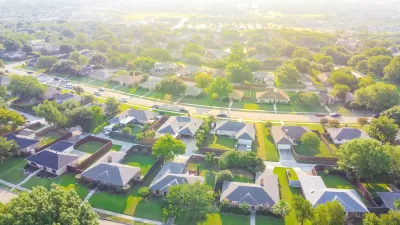What the shoe industry can teach us about the housing crisis.

In an excerpt from their upcoming book, Escaping the Housing Trap: The Strong Towns Response to the Housing Crisis, Charles Marohn and Daniel Herriges claim that “If We Made Shoes Like We Make Housing, People Would Go Barefoot.”
To illustrate their point, the authors write, “Imagine a shoe market that produces only two kinds of shoes: a high-end loafer and an elite-brand tennis shoe.” Companies and governments incentivize the production of just two types of shoe, and “Local permitting restricts the number of shoes that can be made. Rising prices have bloated supply chains, making everything more expensive. The extensive web of public and private capital vested in producing high-end loafers and elite-brand tennis shoes stifles innovation.”
In this world, “Lots of people who want shoes can’t get them. They go barefoot. Those who can buy shoes feel financially squeezed. Price increases are normalized, even expected. Many people are desperate to get any pair of shoes.”
This scenario seems unrealistic—for shoes. “Yet our present housing crisis, which seems normal to us, would be absurd to anyone living a century ago. In the context of millennia of human development, we are the first culture to find ourselves with a chronic shortage of housing.”
For the authors, the answer is clear: “We wiped out the starter rung on the ladder. We need a housing market that produces penny loafers again.”
FULL STORY: If We Made Shoes Like We Make Housing, People Would Go Barefoot

Alabama: Trump Terminates Settlements for Black Communities Harmed By Raw Sewage
Trump deemed the landmark civil rights agreement “illegal DEI and environmental justice policy.”

Study: Maui’s Plan to Convert Vacation Rentals to Long-Term Housing Could Cause Nearly $1 Billion Economic Loss
The plan would reduce visitor accommodation by 25% resulting in 1,900 jobs lost.

Planetizen Federal Action Tracker
A weekly monitor of how Trump’s orders and actions are impacting planners and planning in America.

Restoring Northern India’s Himalayan ‘Water Temples’
Thousands of centuries-old buildings protect the region’s natural springs and serve as community wells and gathering places.

Milwaukee to Double Bike Share Stations
Bublr Bikes, one of the nation’s most successful, will add 500 new e-bikes to its system.

DC Extends Application Window for Outdoor Dining Permits
District restaurants will have until the end of November to apply, but businesses with permits in rush hour parking lanes must end operations on July 31.
Urban Design for Planners 1: Software Tools
This six-course series explores essential urban design concepts using open source software and equips planners with the tools they need to participate fully in the urban design process.
Planning for Universal Design
Learn the tools for implementing Universal Design in planning regulations.
Caltrans
Smith Gee Studio
Institute for Housing and Urban Development Studies (IHS)
City of Grandview
Harvard GSD Executive Education
Toledo-Lucas County Plan Commissions
Salt Lake City
NYU Wagner Graduate School of Public Service




























